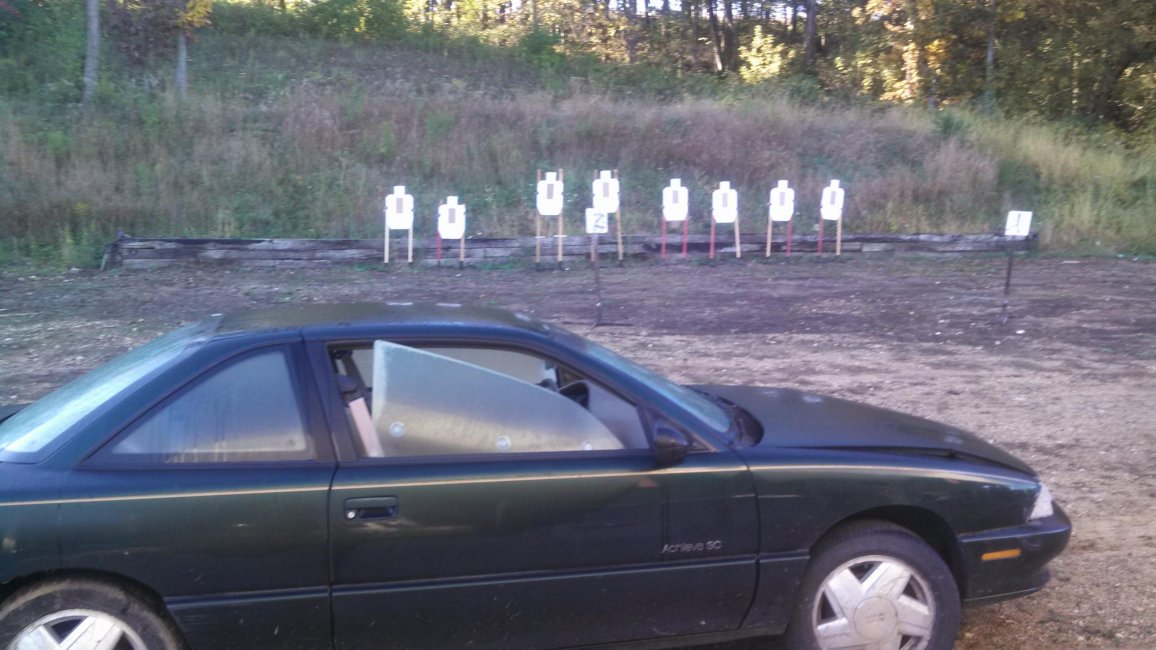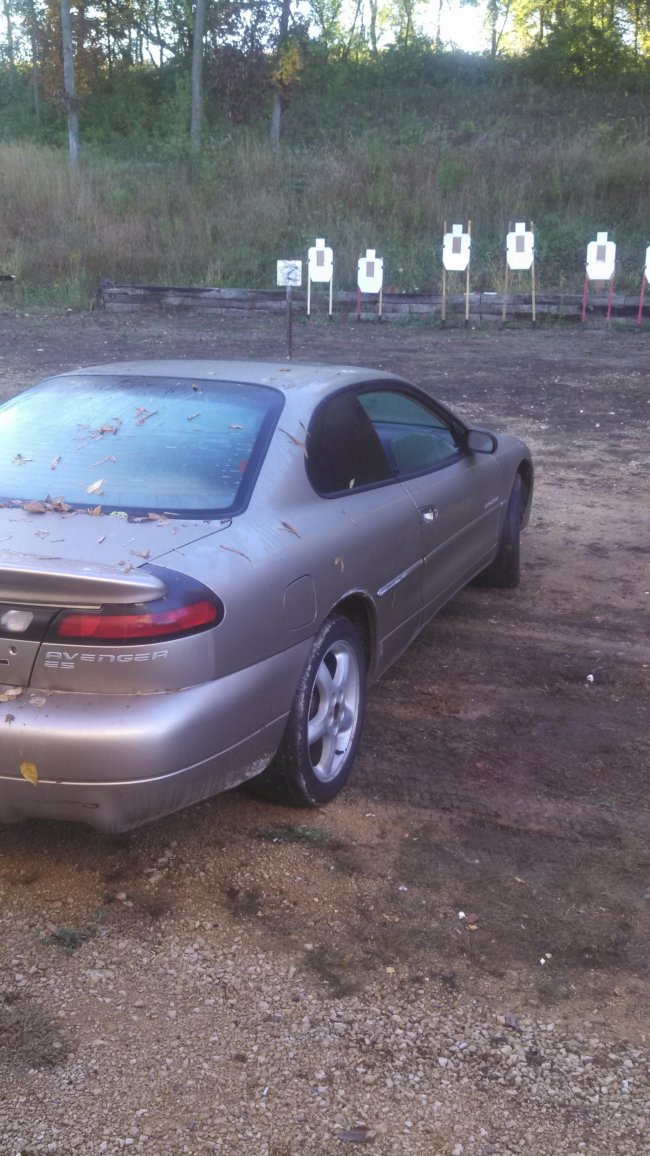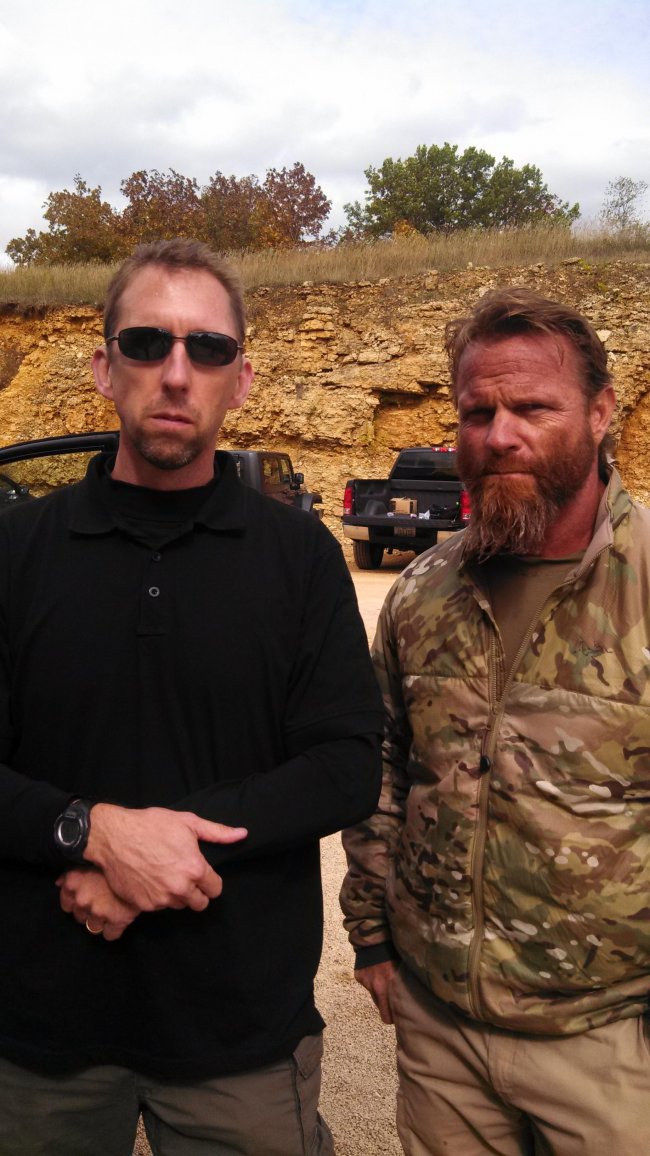What: Dynamic Vehicle Tactics.
When: 5-6OCT2013
Where: Hollows Training Center Mt. Carroll, IL
Who: Pat McNamara. For those not familiar with him, here is a short Bio from the Alias website
Pat McNamara (Mac) has 22 years of Special Operations experience, 13 of which were in 1st SFOD-D. He has extensive experience in hostile fire/combat zones in the Middle East, and Eastern Europe. He trains individuals at basic and advanced levels of marksmanship and combat tactics.
When he worked in the premier special missions unit, he became an impeccable marksman, shooting with accurate, lethal results and tactical effectiveness. McNamara has trained tactical applications of shooting to people of all levels of marksmanship, from varsity level soldiers, and police officers who work the streets to civilians with little to no time behind the trigger.
His military experience quickly taught him that there is more to tactical marksmanship than merely squeezing the trigger. Utilizing his years of experience, McNamara developed a training methodology that is safe, effective and combat relevant and encourages a continuous thought process. This methodology teaches how to maintain safety at all times and choose targets that force accountability, as well as provides courses covering several categories, including individual, collective, on line and standards.
While serving as his Unit's Marksmanship NCO, he developed his own marksmanship club with NRA, CMP, and USPSA affiliations. Mac ran monthly IPSC matches and ran semi annual military marksmanship championships to encourage marksmanship fundamentals and competitiveness throughout the Army.
He retired from the Army's premier hostage rescue unit as a Sergeant Major and is the author of T.A.P.S. (Tactical Application of Practical Shooting).
Gear Used; Glock 19 with RMR. Glock 17 with Pro-sights (D.R. Middlebrooks) S&W M&P15 with Eotech XPS2.0. Back-up Sig5556 with Vortex PST 1-4X. 2nd back up, TSD VEPR .308 w/ iron sights.
Dale Fricke holsters. Viking Tactics and Vickers slings. TSD15 mags.
TD-1 Day one was a shortened version of Mac's 2-day TAPS class. We started of course with safety. The only real difference here was with rule 1. Mac likes to change rule 1 to "Always know the status of your weapon". I can definitely agree with that. "All guns are always loaded" is something we tell kids to scare them. Adults realize this is not true. A safety issue that I am not use to and would come back to haunt me later is Mac's constant use of the safety on the AR. If your sights are not on the target then the weapon is on safe. He includes changing mags in this. When you go dry, you engage the safety, change mags, get back on target and then disengage the safety. "Safety is always an enabler, never a disabler."
After this it was time to send some rounds down range. We started with zeroing at 50 yards. I was a little surprised with how much time we took on this, but down the road when I saw Mac's accuracy requirements, I saw why it was a good idea. After getting dialed in at 50, we moved back to 100 to gather some info. Stuff like, where are you hitting at 100, do you need any more windage adjustment, do you have any parralax issues, and what is the affect when you cat the rifle 90 degrees as if laying it across the hood of a car. Mac calls this "discovery learning". When this was all taken care of we worked some drills that would use what we just did. Theses included the 4 position drill at 50 yards, and "Light the fuse". Yes that one was a lungful.
Lunch. If you go to this facility, bring your own lunch. There is nothing remotely close except the "slurp and burp", and I was afraid to try that one out.
After lunch it was pistol time. Mostly Glocks here with a couple of 1911's, and M&P's. Mac switched from a 1911 to a Glock when he ran out of .45 ammo. We did a few simple drills to see where everyone was at, and get some input from Mac, and then it was on to some of his signature drills along with a modified El Prez. To perform this version of the El Prez we were at 7 yards and were required to make a zone only hits. Each person did three runs with the goal being to get faster each time while maintaining the accuracy of A zone only hits. You would think that knowing this going in, everyone would start slow, make sure to get their hits and then gradually speed up. No, not the case. Once that timer comes out and you know the others are watching you, most people get right into going as fast as they can. I was able to shoot 3 successively faster runs clean for 2 of the 3 times we did this. This was probably only because I knew no one there and didn't really have anything to prove. As soon as I saw I was competitive with some of the faster times, I pushed it and dropped a shot. This is performance based training, not outcome based training.
TD-2
Day 2 started at a different range. One with cars on it. Yay! We started by moving the cars around to set them up in a good format to accomplish the days task. This was done mostly by hand because they weren't exactly in running condition. We also had to drain several inches of water out of one via holes from a .45.


Once everything was set up we went over safety again. It was time for more discovery learning as we tried out various positions and different ways to use the vehicle for cover. We were also reminded that a vehicle is not always cover but maybe only concealment. We did this by shooting various rounds through the cars and seeing how they worked. 9mm usually zipped through, . 40's and .45's, not so much. Weird. Some guys also tried out their duty loads. I, of course, had to bring out the .308 AK and give it a shot.
After this came a lot of shooting. We shot around through and out of the vehicles with both our rifles and pistols. Pistols at steel and carbines at paper. Only A-zone hits were good. We worked some team stuff and did a number of Mac's drills. It was on one of these that the safety thing dinged me. I was having a good run on one of the drills, but upon completion Mac informed me it was a no go because I did not engage my safety during a mag change. Oh well.
Some where in here was lunch and a briefing on VI. (Vehicle interdictions) It was here part of Mac's wide range of knowledge and experience as a Delta Operator started leaking in.(or out, as it were.) After lunch we did some more drills that required us to use not only our marksmanship from the day before but also all of the things we had worked on in the morning.
Thoughts, take aways, and lessons learned.
I'll start with the instructor. Does anyone remember Randy "the Macho Man" Savage. Mac talks like him sometime's. Don't let that mislead you though, he is a great communicator and a deep thinker. He explains what you need to know but doesn't get lost in the minutia. All in all I was pleasantly surprised. I will take another one of his classes.
Something I have griped about before is big class sizes. This was a 20 person class with one instructor. Mac managed the class well, and everyone got some face time, but I still feel 20 people is too many for one instructor. What about those people. There were less than a handful of "regular guys" in the class. Most were LEO's, SWAT team guys at that. This was a very high level class. Good shooters and good gun handlers. This brings me to another point. There was no prereqs listed for this class, but it was definitely not a beginners class. Alias the promoters of the class, should definitely look into recommendations of which classes suit who.
The facilities were so-so. This used to be Blackwater North. I know it has changed hands a few times, and I understand that it is actually in better shape now than a couple of years ago. Hopefully this improvement will continue. The facilities were adequate and safe but not very well maintained.
Teamwork. This was a good class for a partner, especially the second day. Most of the guys there had come with training partners or fellow SWAT team members. I had not even given this a thought. Fortunately there was another lone operator in the class, and I knew him from a prior SI class. That ended up working pretty well. I tried to get Shooter521 to go, but he didn't like the idea of going into IL I guess. (or maybe it was just with me )
)


When: 5-6OCT2013
Where: Hollows Training Center Mt. Carroll, IL
Who: Pat McNamara. For those not familiar with him, here is a short Bio from the Alias website
Pat McNamara (Mac) has 22 years of Special Operations experience, 13 of which were in 1st SFOD-D. He has extensive experience in hostile fire/combat zones in the Middle East, and Eastern Europe. He trains individuals at basic and advanced levels of marksmanship and combat tactics.
When he worked in the premier special missions unit, he became an impeccable marksman, shooting with accurate, lethal results and tactical effectiveness. McNamara has trained tactical applications of shooting to people of all levels of marksmanship, from varsity level soldiers, and police officers who work the streets to civilians with little to no time behind the trigger.
His military experience quickly taught him that there is more to tactical marksmanship than merely squeezing the trigger. Utilizing his years of experience, McNamara developed a training methodology that is safe, effective and combat relevant and encourages a continuous thought process. This methodology teaches how to maintain safety at all times and choose targets that force accountability, as well as provides courses covering several categories, including individual, collective, on line and standards.
While serving as his Unit's Marksmanship NCO, he developed his own marksmanship club with NRA, CMP, and USPSA affiliations. Mac ran monthly IPSC matches and ran semi annual military marksmanship championships to encourage marksmanship fundamentals and competitiveness throughout the Army.
He retired from the Army's premier hostage rescue unit as a Sergeant Major and is the author of T.A.P.S. (Tactical Application of Practical Shooting).
Gear Used; Glock 19 with RMR. Glock 17 with Pro-sights (D.R. Middlebrooks) S&W M&P15 with Eotech XPS2.0. Back-up Sig5556 with Vortex PST 1-4X. 2nd back up, TSD VEPR .308 w/ iron sights.
Dale Fricke holsters. Viking Tactics and Vickers slings. TSD15 mags.
TD-1 Day one was a shortened version of Mac's 2-day TAPS class. We started of course with safety. The only real difference here was with rule 1. Mac likes to change rule 1 to "Always know the status of your weapon". I can definitely agree with that. "All guns are always loaded" is something we tell kids to scare them. Adults realize this is not true. A safety issue that I am not use to and would come back to haunt me later is Mac's constant use of the safety on the AR. If your sights are not on the target then the weapon is on safe. He includes changing mags in this. When you go dry, you engage the safety, change mags, get back on target and then disengage the safety. "Safety is always an enabler, never a disabler."
After this it was time to send some rounds down range. We started with zeroing at 50 yards. I was a little surprised with how much time we took on this, but down the road when I saw Mac's accuracy requirements, I saw why it was a good idea. After getting dialed in at 50, we moved back to 100 to gather some info. Stuff like, where are you hitting at 100, do you need any more windage adjustment, do you have any parralax issues, and what is the affect when you cat the rifle 90 degrees as if laying it across the hood of a car. Mac calls this "discovery learning". When this was all taken care of we worked some drills that would use what we just did. Theses included the 4 position drill at 50 yards, and "Light the fuse". Yes that one was a lungful.
Lunch. If you go to this facility, bring your own lunch. There is nothing remotely close except the "slurp and burp", and I was afraid to try that one out.
After lunch it was pistol time. Mostly Glocks here with a couple of 1911's, and M&P's. Mac switched from a 1911 to a Glock when he ran out of .45 ammo. We did a few simple drills to see where everyone was at, and get some input from Mac, and then it was on to some of his signature drills along with a modified El Prez. To perform this version of the El Prez we were at 7 yards and were required to make a zone only hits. Each person did three runs with the goal being to get faster each time while maintaining the accuracy of A zone only hits. You would think that knowing this going in, everyone would start slow, make sure to get their hits and then gradually speed up. No, not the case. Once that timer comes out and you know the others are watching you, most people get right into going as fast as they can. I was able to shoot 3 successively faster runs clean for 2 of the 3 times we did this. This was probably only because I knew no one there and didn't really have anything to prove. As soon as I saw I was competitive with some of the faster times, I pushed it and dropped a shot. This is performance based training, not outcome based training.
TD-2
Day 2 started at a different range. One with cars on it. Yay! We started by moving the cars around to set them up in a good format to accomplish the days task. This was done mostly by hand because they weren't exactly in running condition. We also had to drain several inches of water out of one via holes from a .45.



Once everything was set up we went over safety again. It was time for more discovery learning as we tried out various positions and different ways to use the vehicle for cover. We were also reminded that a vehicle is not always cover but maybe only concealment. We did this by shooting various rounds through the cars and seeing how they worked. 9mm usually zipped through, . 40's and .45's, not so much. Weird. Some guys also tried out their duty loads. I, of course, had to bring out the .308 AK and give it a shot.
After this came a lot of shooting. We shot around through and out of the vehicles with both our rifles and pistols. Pistols at steel and carbines at paper. Only A-zone hits were good. We worked some team stuff and did a number of Mac's drills. It was on one of these that the safety thing dinged me. I was having a good run on one of the drills, but upon completion Mac informed me it was a no go because I did not engage my safety during a mag change. Oh well.
Some where in here was lunch and a briefing on VI. (Vehicle interdictions) It was here part of Mac's wide range of knowledge and experience as a Delta Operator started leaking in.(or out, as it were.) After lunch we did some more drills that required us to use not only our marksmanship from the day before but also all of the things we had worked on in the morning.
Thoughts, take aways, and lessons learned.
I'll start with the instructor. Does anyone remember Randy "the Macho Man" Savage. Mac talks like him sometime's. Don't let that mislead you though, he is a great communicator and a deep thinker. He explains what you need to know but doesn't get lost in the minutia. All in all I was pleasantly surprised. I will take another one of his classes.
Something I have griped about before is big class sizes. This was a 20 person class with one instructor. Mac managed the class well, and everyone got some face time, but I still feel 20 people is too many for one instructor. What about those people. There were less than a handful of "regular guys" in the class. Most were LEO's, SWAT team guys at that. This was a very high level class. Good shooters and good gun handlers. This brings me to another point. There was no prereqs listed for this class, but it was definitely not a beginners class. Alias the promoters of the class, should definitely look into recommendations of which classes suit who.
The facilities were so-so. This used to be Blackwater North. I know it has changed hands a few times, and I understand that it is actually in better shape now than a couple of years ago. Hopefully this improvement will continue. The facilities were adequate and safe but not very well maintained.
Teamwork. This was a good class for a partner, especially the second day. Most of the guys there had come with training partners or fellow SWAT team members. I had not even given this a thought. Fortunately there was another lone operator in the class, and I knew him from a prior SI class. That ended up working pretty well. I tried to get Shooter521 to go, but he didn't like the idea of going into IL I guess. (or maybe it was just with me
 )
)






 Just sayin'.
Just sayin'. 

